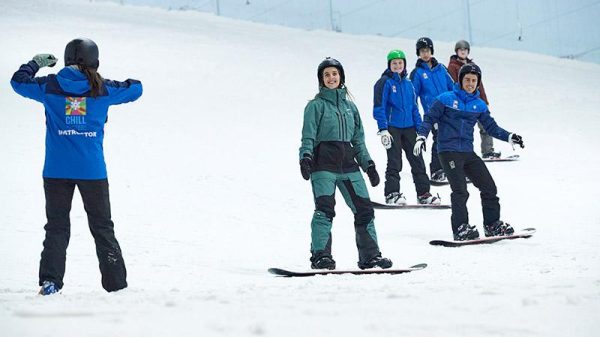In today’s rapidly evolving educational landscape, the integration of diverse activities into school curriculums is more important than ever. Among the myriad of possibilities, extreme sports stand out as a captivating yet contentious option. While traditionally viewed as extracurricular, these high-adrenaline activities are increasingly being considered for inclusion in formal education. This shift invites educators, parents, and policymakers to re-evaluate the potential benefits and challenges of such a bold move. By exploring the physical, mental, and social advantages that extreme sports can offer, alongside the safety and accessibility concerns, we can better understand their place in shaping well-rounded, resilient, and dynamic students. With an optimistic lens, this article delves into the question: Should extreme sports be part of school curriculums? Join us as we navigate this exciting frontier, uncovering how these sports might enrich educational experiences and prepare students for a world that values courage, adaptability, and innovation.
Understanding the Benefits of Extreme Sports in Education
Integrating extreme sports into educational frameworks can offer numerous advantages that go beyond the physical. Engagement in extreme sports can enhance cognitive skills such as problem-solving, decision-making, and critical thinking. Students are often required to assess risks and make quick, informed decisions, which can translate into improved academic performance and better preparation for real-world challenges.
Moreover, these sports foster a unique sense of camaraderie and teamwork. Participants learn to trust their peers, communicate effectively, and work together towards a common goal. This experience can be invaluable in developing social skills and building confidence. Consider the following benefits:
- Boosts Physical Health: Encourages fitness and an active lifestyle.
- Enhances Emotional Resilience: Teaches students to manage fear and stress.
- Promotes Environmental Awareness: Many extreme sports take place outdoors, fostering a connection with nature.
With these multifaceted benefits, extreme sports can be a transformative addition to school curriculums, preparing students not only academically but also for life’s varied challenges.

Incorporating Safety Measures for School-Based Extreme Sports
When integrating extreme sports into school curriculums, prioritizing safety is paramount. Schools can establish a robust framework by implementing a series of precautionary measures designed to minimize risks while maximizing student engagement and enjoyment. To start, ensure that all sports activities are supervised by certified instructors who are well-versed in the specific sport’s safety protocols. This not only includes the technical aspects of the sport but also emergency response procedures.
- Regular Equipment Inspections: Conduct routine checks to ensure that all gear and equipment meet safety standards. Replace any damaged or outdated items promptly.
- Comprehensive Training Programs: Develop training sessions that emphasize not only skill development but also the importance of safety measures and injury prevention.
- Emergency Preparedness: Equip instructors and students with the knowledge and tools to handle potential emergencies, including first aid training and clear communication channels.
- Risk Assessment: Before each session, conduct a thorough risk assessment to identify potential hazards and establish protocols to address them.
By embedding these safety measures into the curriculum, schools can create a secure environment that allows students to explore the thrilling world of extreme sports with confidence. Embracing these practices ensures that the excitement of pushing physical limits is balanced with a commitment to student welfare.

Designing an Inclusive Extreme Sports Curriculum for All Students
Creating a curriculum that embraces extreme sports requires a thoughtful approach to ensure it is inclusive and accessible for all students. Safety is a top priority, and providing proper equipment and training is essential to help students participate confidently. Schools can collaborate with professional extreme sports organizations to offer workshops and demonstrations, allowing students to learn from experienced athletes. Furthermore, modifying activities to accommodate varying skill levels can encourage participation from all students, regardless of their physical abilities.
Incorporating extreme sports into the school curriculum also opens up opportunities for teaching valuable life skills. Problem-solving and decision-making are natural components of these sports, as students must assess risks and make quick judgments. To support an inclusive environment, schools can consider the following strategies:
- Implement adaptive equipment and techniques for students with disabilities.
- Offer a variety of sports to cater to different interests and abilities.
- Ensure cultural and gender inclusivity by highlighting diverse role models in extreme sports.
- Provide mental health support to help students manage fear and anxiety associated with high-risk activities.
By embracing these strategies, schools can cultivate a more dynamic and inclusive learning environment that not only promotes physical health but also empowers students with resilience and confidence.

Empowering Students Through Thrilling Athletic Experiences
Incorporating extreme sports into school curriculums can significantly enhance students’ personal development by pushing their boundaries and encouraging resilience. These sports offer a unique opportunity for young people to engage in physical activities that are both thrilling and educational. By participating in activities such as rock climbing, mountain biking, or skateboarding, students not only improve their physical fitness but also develop crucial life skills such as teamwork, problem-solving, and risk management.
- Teamwork: Many extreme sports require collaboration, fostering a spirit of camaraderie and mutual support among students.
- Problem-solving: Navigating the challenges of an extreme sport often requires quick thinking and adaptability, enhancing critical thinking skills.
- Risk management: Students learn to assess risks and make informed decisions, preparing them for real-world challenges.
Furthermore, these activities can inspire a lifelong passion for physical fitness and outdoor adventure, promoting a healthy lifestyle. As educators, we have the opportunity to empower students by integrating these exhilarating experiences into their education, creating a dynamic and engaging learning environment.










